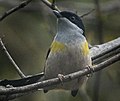| Shrike-babblers | |
|---|---|
 | |
| Blyth's shrike-babbler (Pteruthius aeralatus) | |
| Scientific classification | |
| Kingdom: | Animalia |
| Phylum: | Chordata |
| Class: | Aves |
| Order: | Passeriformes |
| Family: | Vireonidae |
| Genus: | Pteruthius Swainson, 1832 |
| Type species | |
| Lanius erythropterus [1] Vigors, 1831 | |
The shrike-babblers are a group of small birds in the genus Pteruthius. They are native to the Indomalayan realm, and were traditionally placed in the family Timaliidae before molecular phylogenetic studies in 2007 found that they were best considered as belonging to the family Vireonidae which was then thought to be restricted to the New World. They were traditionally classified into five species with several subspecies but changes in the status of these species on the basis of the phylogenetic species concept suggest more forms in a cryptic species complex. [2] [3] Most species are found in montane forests, with some species descending down to lower altitudes during the winter.
Contents
The shrike-babblers range in size from 11.5–20 cm in length and weigh 10-48 g. They are divergent in plumage and size but all possess a stout black hooked bill, short rictal bristles and a distinctive juvenile plumage. They all exhibit sexual dimorphism in plumage, with the males generally brighter. The song is simple and monotonous. [2]
None of the species are considered threatened by human activities.














